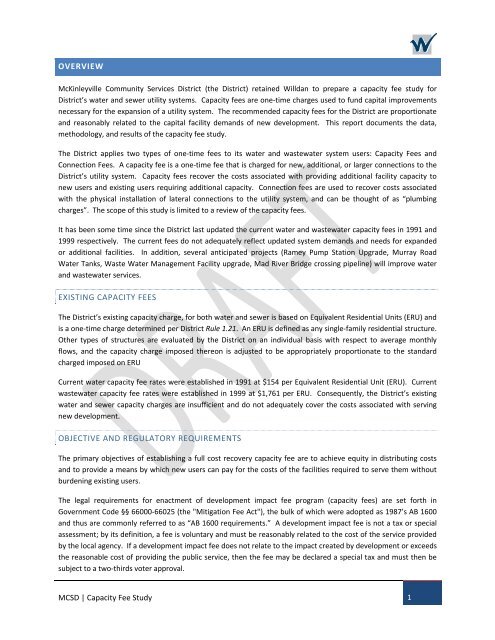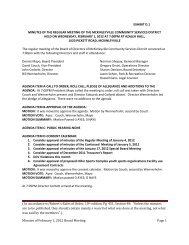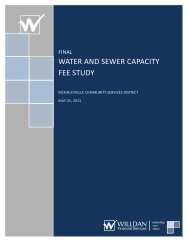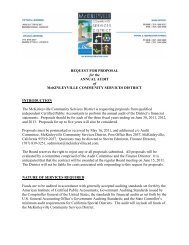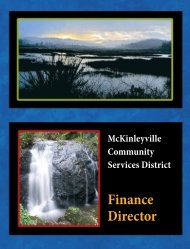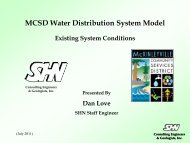water and sewer capacity fee study - McKinleyville Community ...
water and sewer capacity fee study - McKinleyville Community ...
water and sewer capacity fee study - McKinleyville Community ...
- No tags were found...
You also want an ePaper? Increase the reach of your titles
YUMPU automatically turns print PDFs into web optimized ePapers that Google loves.
OVERVIEW<strong>McKinleyville</strong> <strong>Community</strong> Services District (the District) retained Willdan to prepare a <strong>capacity</strong> <strong>fee</strong> <strong>study</strong> forDistrict’s <strong>water</strong> <strong>and</strong> <strong>sewer</strong> utility systems. Capacity <strong>fee</strong>s are one-time charges used to fund capital improvementsnecessary for the expansion of a utility system. The recommended <strong>capacity</strong> <strong>fee</strong>s for the District are proportionate<strong>and</strong> reasonably related to the capital facility dem<strong>and</strong>s of new development. This report documents the data,methodology, <strong>and</strong> results of the <strong>capacity</strong> <strong>fee</strong> <strong>study</strong>.The District applies two types of one-time <strong>fee</strong>s to its <strong>water</strong> <strong>and</strong> waste<strong>water</strong> system users: Capacity Fees <strong>and</strong>Connection Fees. A <strong>capacity</strong> <strong>fee</strong> is a one-time <strong>fee</strong> that is charged for new, additional, or larger connections to theDistrict’s utility system. Capacity <strong>fee</strong>s recover the costs associated with providing additional facility <strong>capacity</strong> tonew users <strong>and</strong> existing users requiring additional <strong>capacity</strong>. Connection <strong>fee</strong>s are used to recover costs associatedwith the physical installation of lateral connections to the utility system, <strong>and</strong> can be thought of as “plumbingcharges”. The scope of this <strong>study</strong> is limited to a review of the <strong>capacity</strong> <strong>fee</strong>s.It has been some time since the District last updated the current <strong>water</strong> <strong>and</strong> waste<strong>water</strong> <strong>capacity</strong> <strong>fee</strong>s in 1991 <strong>and</strong>1999 respectively. The current <strong>fee</strong>s do not adequately reflect updated system dem<strong>and</strong>s <strong>and</strong> needs for exp<strong>and</strong>edor additional facilities. In addition, several anticipated projects (Ramey Pump Station Upgrade, Murray RoadWater Tanks, Waste Water Management Facility upgrade, Mad River Bridge crossing pipeline) will improve <strong>water</strong><strong>and</strong> waste<strong>water</strong> services.EXISTING CAPACITY FEESThe District’s existing <strong>capacity</strong> charge, for both <strong>water</strong> <strong>and</strong> <strong>sewer</strong> is based on Equivalent Residential Units (ERU) <strong>and</strong>is a one-time charge determined per District Rule 1.21. An ERU is defined as any single-family residential structure.Other types of structures are evaluated by the District on an individual basis with respect to average monthlyflows, <strong>and</strong> the <strong>capacity</strong> charge imposed thereon is adjusted to be appropriately proportionate to the st<strong>and</strong>ardcharged imposed on ERUCurrent <strong>water</strong> <strong>capacity</strong> <strong>fee</strong> rates were established in 1991 at $154 per Equivalent Residential Unit (ERU). Currentwaste<strong>water</strong> <strong>capacity</strong> <strong>fee</strong> rates were established in 1999 at $1,761 per ERU. Consequently, the District’s existing<strong>water</strong> <strong>and</strong> <strong>sewer</strong> <strong>capacity</strong> charges are insufficient <strong>and</strong> do not adequately cover the costs associated with servingnew development.OBJECTIVE AND REGULATORY REQUIREMENTSThe primary objectives of establishing a full cost recovery <strong>capacity</strong> <strong>fee</strong> are to achieve equity in distributing costs<strong>and</strong> to provide a means by which new users can pay for the costs of the facilities required to serve them withoutburdening existing users.The legal requirements for enactment of development impact <strong>fee</strong> program (<strong>capacity</strong> <strong>fee</strong>s) are set forth inGovernment Code §§ 66000-66025 (the "Mitigation Fee Act"), the bulk of which were adopted as 1987’s AB 1600<strong>and</strong> thus are commonly referred to as “AB 1600 requirements.” A development impact <strong>fee</strong> is not a tax or specialassessment; by its definition, a <strong>fee</strong> is voluntary <strong>and</strong> must be reasonably related to the cost of the service providedby the local agency. If a development impact <strong>fee</strong> does not relate to the impact created by development or exceedsthe reasonable cost of providing the public service, then the <strong>fee</strong> may be declared a special tax <strong>and</strong> must then besubject to a two-thirds voter approval.MCSD | Capacity Fee Study 1


